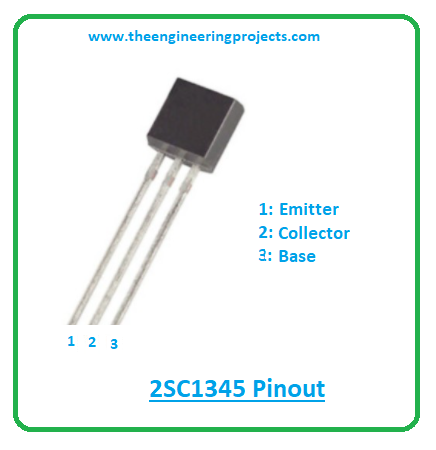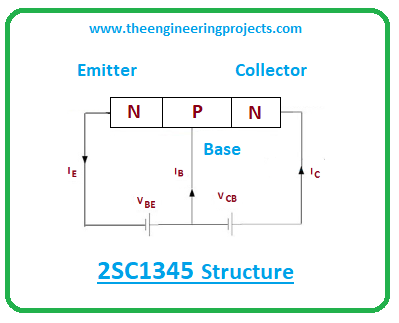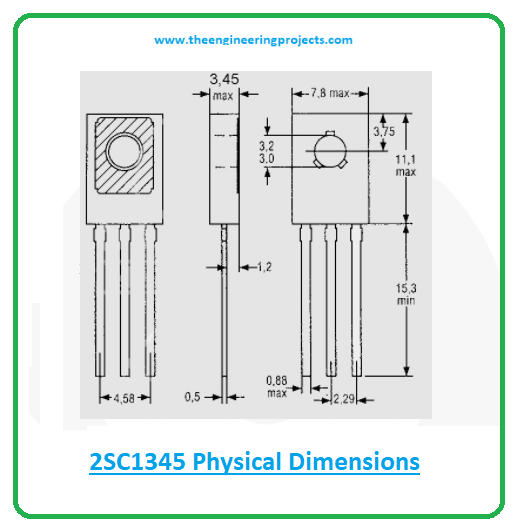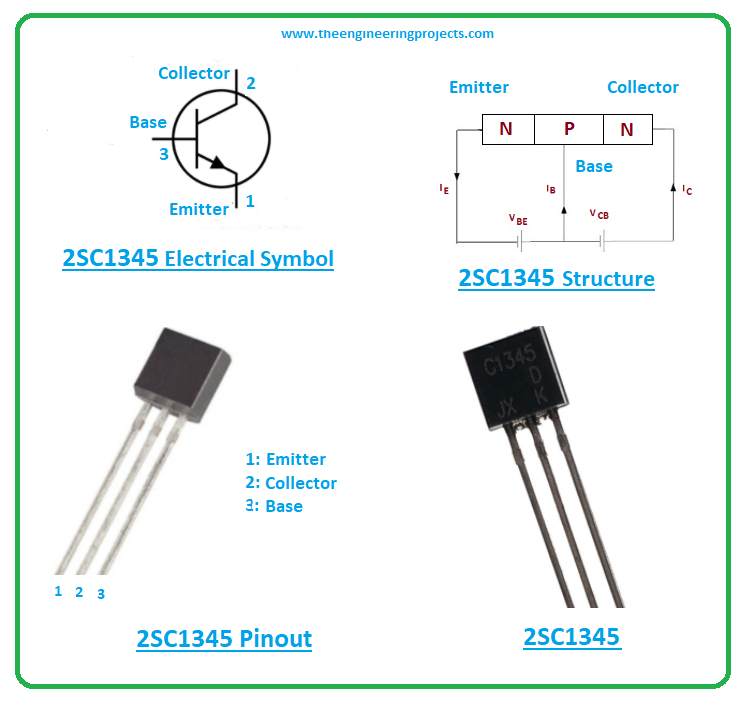
Hi Guys! Hope you’re well today. In today's tutorial, we will have a look at the 2SC1345 NPN Transistor. We will also discuss 2SC1345 Datasheet, Pinout, Power Ratings, Equivalents & Applications. As this is an NPN transistor, the conductivity is mainly carried out by electrons as the major charge carriers. 2SC1345 is mainly used for switching and amplification purposes.
Let's first recall NPN transistors: NPN transistor comes with 3 terminals, named:
- Emitter
- Collector
- Base
If the voltage at the base terminal is above 0.7V, the NPN transistor gets forward biased & starts conducting i.e. current will flow from the Collector to Emitter terminal. If the Base voltage is less than 0.7V, it remains reverse-biased.
So now let’s get started with the 2SC1345 NPN Transistor.
2SC1345 NPN Transistor
- 2SC1345 is a bipolar junction transistor that belongs to the NPN transistor family.
- It is composed of silicon semiconductor material and comes in a TO-92 package.
- 2SC1345 contains three layers where one is a p-doped layer and the other two are n-doped layers. The p-doped layer stands between the two n-doped layers.

- This device contains three terminals named: the base, collector, and emitter. The small current change at the base side is used to produce a large output current at the remaining terminals.

- The bipolar junction transistors are available in two types i.e. NPN transistors and PNP transistors. Both holes and electrons play a role in the conductivity inside the transistors the reason they are called bipolar devices.
- However, these devices differ in terms of major charge carriers. In the case of NPN transistors, electrons are the major charge carriers and in PNP transistors holes are the major charge carriers.
- These bipolar devices are called current-controlled devices in opposed to MOSFETs that are termed voltage-controlled devices and contain terminals like a drain, source, and gate.
- It is important to note that the mobility of holes is less efficient than the mobility of electrons the reason NPN transistors are preferred over PNP transistors for a range of applications.
2SC1345 Datasheet
Before you apply this component to your electrical project, it’s wise to scan through the 2SC1345 datasheet that features the main characteristics of the device. Click the link below to download the 2SC1345 datasheet.
2SC1345 Pinout
The following figure shows the 2SC1345 pinout.

2SC1345 Working Principle
When voltage is applied at the base terminal, it will bias the device and as a result, current starts flowing from collector to emitter terminal.
- Know that, bipolar junction devices are not symmetrical in nature. This means if we exchange the emitter and collector terminals then these terminals will stop working in the forward active region and start working in reverse active mode.
- The non-symmetry of these devices is due to the different doping concentrations of all three terminals.
2SC1345 Power Ratings
The following table represents the 2SC1345 power ratings.| Absolute Maximum Ratings of 2SC1345 | ||||
|---|---|---|---|---|
| Pin No. | Pin Description | Pin Name | ||
| 1 | Collector-emitter voltage | 50V | ||
| 2 | Collector-base voltage | 550V | ||
| 3 | Base-emitter voltage | 5V | ||
| 4 | Collector current | 0.1A | ||
| 5 | Power dissipation | 0.2W | ||
| 6 | Base current | 0.05A | ||
| 7 | Operating junction temperature range | 150C | ||
- The collector-emitter voltage is 50V and the collector-base voltage is 550V. The emitter-base voltage is 5V which is the voltage required to bias the device.
- The collector-current is 100mA which means it can support load under 100mA.
- The power dissipation is 0.2W which is equal to the amount of energy released during the functioning of this component.
- The current gain is 250 to 1200 which is the amount of current this device can amplify.
- When working with this device, make sure these ratings don’t exceed the absolute maximum ratings else they can damage the device.
- Moreover, if these ratings are applied more than the required time, they can affect the device's reliability.
2SC1345 Equivalents
The following are the 2SC1345 equivalents.- 2SC2240
- KSC1845FTA (Fairchild)
2SC1345 Applications
The following are the 2SC1345 applications.- Used in electronic Ballasts.
- Used in a common power amplifier.
- Used in voltage regulator circuits.
- Incorporated in modern electronic circuits.
- Used in Bistable and Astable multivibrators circuit.
- Used in energy-saving lights.
- Used in high-frequency power transform.
- Used in the high switching power supply.
- Employed to support loads under 0.1A.
2SC1345 Physical Dimensions
The following diagram shows the 2SC1345 physical dimensions.




